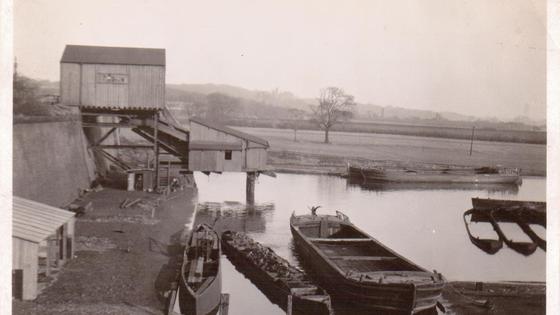
Elaine is a local volunteer researching and sharing the heritage stories linked to Salford's Bridgewater Canal. These are her very personal memories of a childhood living beside the canal in Boothstown.
"Thinking back to my Boothstown childhood, I recall a small village where everyone knew your name and your family. A mill chimney, the coal mine, dark damp terraced houses, the coal man, the mobile greengrocer, the Corona pop man, Mr Curwin delivering milk from the dairy down the lane, long hot sunny summer days playing in wheat fields, making dens in the ‘fairy glen’, climbing trees to the very top, tying a scarf over your nose to protect from smog, holding your nose when you ran past the pig farm down the lane towards the forbidden lands…. the canal basin at Boothstown.
All true! It was the 1960s. My school had just three classrooms - Mrs Laithwaite (infants), Mrs Johnson (middle school) and Mrs Tristrum (top school). We walked to Ellenbrook Church through the wheat fields as the bus rarely turned up in time for the service. Our entertainment was held in the church institute on Vicars Hall Lane, Brownies in the week, a mobile library. I seem to remember a Saturday film club showing The Lone Ranger and Laurel and Hardy. My family had the choice of two local occupations - mining or mill work. My great uncles still worked at Astley Green Colliery until its closure in 1970 and my dad worked for a short time at Mosley Common Colliery. My grandma and great aunts worked in Yates Mill, spinning and weaving cotton. Families were close in those days and because there were so many family members living in Boothstown I would often sneak off with my friends to our favourite playground, the canal.
At the bottom of our garden ran the railway from Mosley Common pit to the coal chute on the canal bank. When I was little my brother and I ran upstairs to watch the trains from my bedroom window. In springtime we used to pick pussy willow from the railway embankment and took the shortcut to the park and the football field by crossing the line. After the closure of the pit and the dismantling of the railway, the canal basin and surrounding land provided a treasure trove for imaginative children, especially as we were ‘banned’ by our parents. It was exciting!
Before the chute was finally dismantled we used to dare each other to jump from one side to the other across the chute. Never one to be called ‘chicken’, I made the leap once. Can you imagine? My heart skips a beat now when I think of it. The chute, it was easily 30ft above the canal and I was probably only ten years old at the time. There were no fences either to secure the building, we used to tightrope on the remaining rails and tie each other up re-enacting the silent movies where the maiden was tied to rails and the hero rescues her just in the nick of time. By now the disused canal basin was smelly, with sunken barges, stagnant water and all manner of rubbish. The boys used to poke sticks into the swollen bellies of dead animals, Yuk! One day I raced back home to fetch my dad as a local bully had stolen my bike. Dad caught hold of her just as she was about to throw it into the water. He marched her back to her house and ‘talked’ to her dad. It wouldn’t happen today? Needless to say, she didn’t bully me again and my bike was safe.
Other than the railway line there was Booths Hall Lane which ran down and across the canal via a bridge. This was used by the bin lorries as there was a tip on the south side of the canal. I definitely pushed the boundaries in those days because my friend and I walked past the tip down the lane, ignored the Bridgewater Estates' ‘Private’ sign and were promptly caught and marched back to the lane by the wardens. We were only exploring, and playing at being spies...
Other canalside memories include walks to Worsley in the summer holiday with my family. We would take a picnic and play in Worsley Woods. If we were lucky (and mum could afford it) we had an ice cream from the café before walking back home. In the autumn we would go to Botany Bay Woods with mum and Aunty Sheila collecting blackberries ready to bake lots of pies and in the winter we skated on the frozen ‘lake’, which I now know was the Chaddock Levels. The canal was also a means of getting from A to B. My grandma lived in Patricroft and when money was tight we walked along the canal to visit her.
Progress caught up with us in Boothstown as in the 1970s new housing replaced the mill, the farms, many of the old terraced houses and the land of our imagination was lost forever".
Image of Boothstown Coal Chute by kind permission of the Peel Archive.







